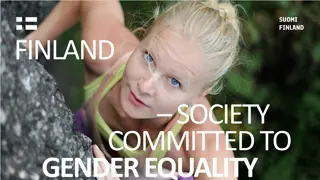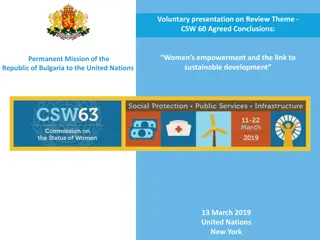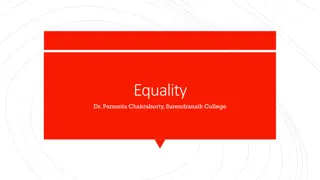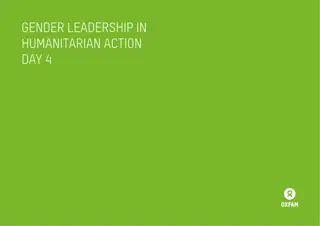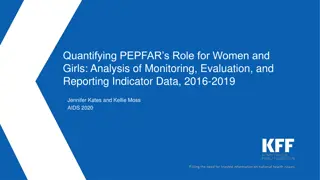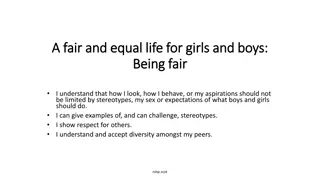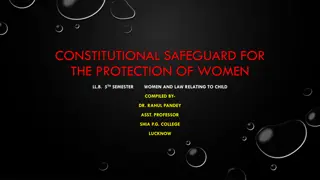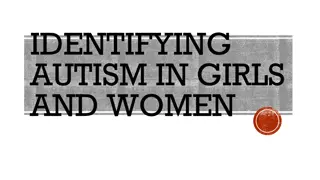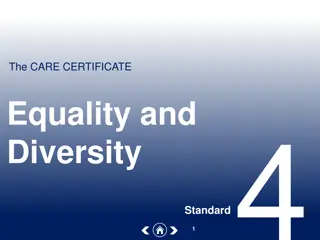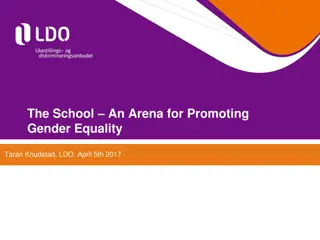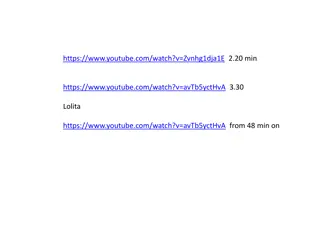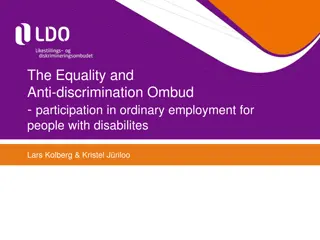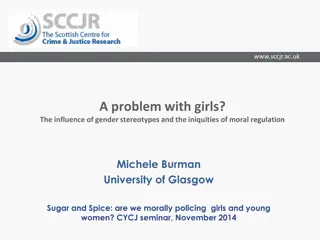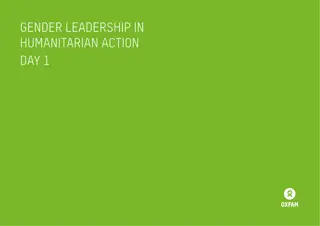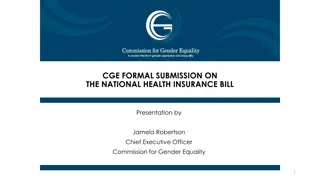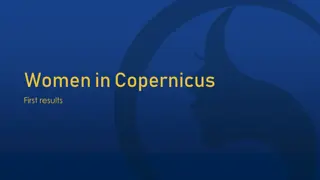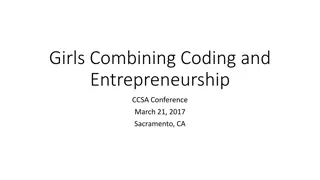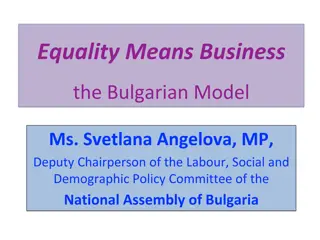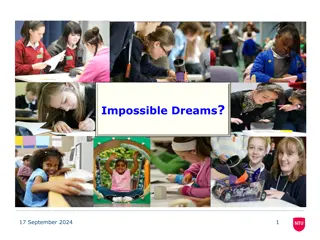Challenging Misogyny and Promoting Equality for Girls and Women
Addressing the importance of combating misogynistic attitudes toward girls and women, this content emphasizes the need for gender equality, highlighting issues such as gender pay gap, underrepresentation in politics, and harmful stereotypes. It explores the legal context of discrimination protection and the significance of recognizing and addressing misogynistic behaviors in various forms like language, social media misuse, and sexual harassment.
Download Presentation

Please find below an Image/Link to download the presentation.
The content on the website is provided AS IS for your information and personal use only. It may not be sold, licensed, or shared on other websites without obtaining consent from the author. Download presentation by click this link. If you encounter any issues during the download, it is possible that the publisher has removed the file from their server.
E N D
Presentation Transcript
GET IT RIGHT FOR GIRLS Challenging misogynistic attitudes among children and young people
Misogyny has no place in our schools or in the lives of our young people so let s Get it Right for Girls in the certain knowledge that by doing so, we also get it right for boys and for society. Mary Matheson, EIS Equality Committee Vice-Convener, 2012-16
Why focus on women and girls? There has been progress towards gender equality but much ground still to be covered Gender pay gap still 11.5% Women are only 29% of MPs/35% of MSPs Sexist attitudes evident in various forms in educational establishments, from language to behaviour Misogyny and sexist stereotyping has short and long term consequences for individuals and society Women and girls are more often the targets of sexist behaviour than men and boys
Legal context (1) The Equality Act 2010 identifies sex as a protected characteristic. You must not be discriminated against because you are (or are not) a particular sex. The Act protects people from direct and indirect discrimination, and also from sexual harassment. This is when someone makes you feel humiliated, offended or degraded because of 'unwanted conduct of a sexual nature . Schools and colleges are bound by the Public Sector Equality Duty, part of the Act, to: a) eliminate discrimination, harassment, victimisation, and any other conduct prohibited by the Act b) advance equality of opportunity between persons who share a protected characteristic and persons who do not share it c) foster good relations between persons who share a protected characteristic and persons who do not share it
Legal context (2) Gender reassignment is also a protected characteristic under the Equality Act 2010. This protects people who are transgender/transsexual, at any stage of transition. Pregnancy and marital status are also protected under the Equality Act. The Act explains that advancing equality involves: Removing or minimising disadvantages suffered by people due to their protected characteristics Taking steps to meet the needs of people from protected groups where these are different from the needs of other people Encouraging people from protected groups to participate in public life or in other activities where their participation is disproportionately low
Recognising misogynistic attitudes and behaviour Language Attitudes Social media misuse Sexual bullying and harassment Gender policing Violence against women
Classroom experiences Pupils commonly use words like slut but don t even know what it means HE Lecturer, Aberdeen A P1 class was watching a news story about the women s World Cup and a boy said I didn t know women played football Primary Teacher, Aberdeen A pupil in my class called me a fat f***ing whore Secondary Teacher - Fife The children were doing a puzzle to confront stereotyping [where you assume a surgeon is male] and when a pupil said, The surgeon could be his mum , the class laughed at him Primary Teacher, Edinburgh
Dangerous consequences Short Term Long Term Sexual bullying and harassment - sexualised verbal abuse - sexual assault - non-consensual image sharing Violence against women - physical, sexual and psychological violence including domestic abuse, rape, child sexual abuse - sexual harassment - commercial sexual exploitation - Female Genital Mutilation - forced and child marriages Gender policing - stereotypes - peer-group pressure Gender inequality in the economy - gender pay and income gap - occupational segregation Fear, anxiety and stress - impacts on health and wellbeing - impacts on educational outcomes Under-representation of women in public life - fewer women MPs and MSPs - fewer women in senior roles - sexism in the media
Suggested strategies to combat misogyny: Policy and practice Develop a whole school policy which addresses gender equality and violence against women Analyse data by gender to inform policy and practice and identify inadvertent discrimination
Suggested strategies: Ethos Have a school mission statement which reflects gender issues Safeguard against stereotyping Hold regular and open discussion on gender issues Hold themed assemblies Ensure consistent approaches by all staff Challenge group-think Consider peer-to-peer anti-sexism education Agree with pupils a list of unacceptable words Hold discussions on subject choice
Suggested strategies: Curriculum Explicitly explore the topic within subjects such as Modern Studies, RME, English, History, Drama, PSE and Art Embed in Health and Wellbeing approaches Address a wide range of issues including body image, media portrayals of women, gender equality Use cross-curricular approaches Mark special awareness days e.g. International Women s Day (8th March) Consider how misogyny might affect subject choice
Suggested strategies: CPD Equality & Diversity training for teachers and support staff which explicitly includes gender and violence against women Adequate information and guidance on equality legislation Guidance on legal issues around the sharing of images and accompanying child protection issues Greater links between equality issues, including gender equality, and the Professional Update process
Suggested strategies: Partnership working Support parents to understand the issues, particularly with regard to the use of social media for sexual bullying and harassment, and as a child protection issue Develop meaningful and sustained engagement with specialist voluntary organisations who can help embed anti-sexism education across the whole school Visits from the police to highlight the seriousness of sexual bullying, misogynistic abuse on social media and violence against women Education Scotland addressing the issue of gender equality within HGIOs (How Good is Our School?) and inspection and review
Recommended action for EIS members 1. Use Use this guidance as the basis of discussion on the issue of misogynistic attitudes among young people at EIS branch level. 2. Raise Raise any emerging issues with the school/college management team. 3. Seek Seek review of current establishment policy and practice where required in light of this advice.
4. Consult Consult with the local EIS Equality Rep and / or the Local Association or Branch Secretary in the event that additional advice / support is needed. 5. Request Request access where necessary to relevant Professional Learning opportunities. 6. Share Share any examples of strongly gender inclusive practice with the EIS Equality Department. 7. Continue Continue to monitor policies in terms of their effectiveness in eradicating gender discrimination and promoting equality.
Sexist language and behaviour is unacceptable in school and college communities. Whilst educational establishments cannot eradicate the misogyny which exists in our society, they can and do play a vital role in challenging it Larry Flanagan, EIS General Secretary
email: equality@eis.org.uk Get It Right for Girls report and PowerPoint http://www.eis.org.uk/Equality/Gender.htm EIS equality policies and guidance http://www.eis.org.uk/Equality/Ed_Publications.htm



